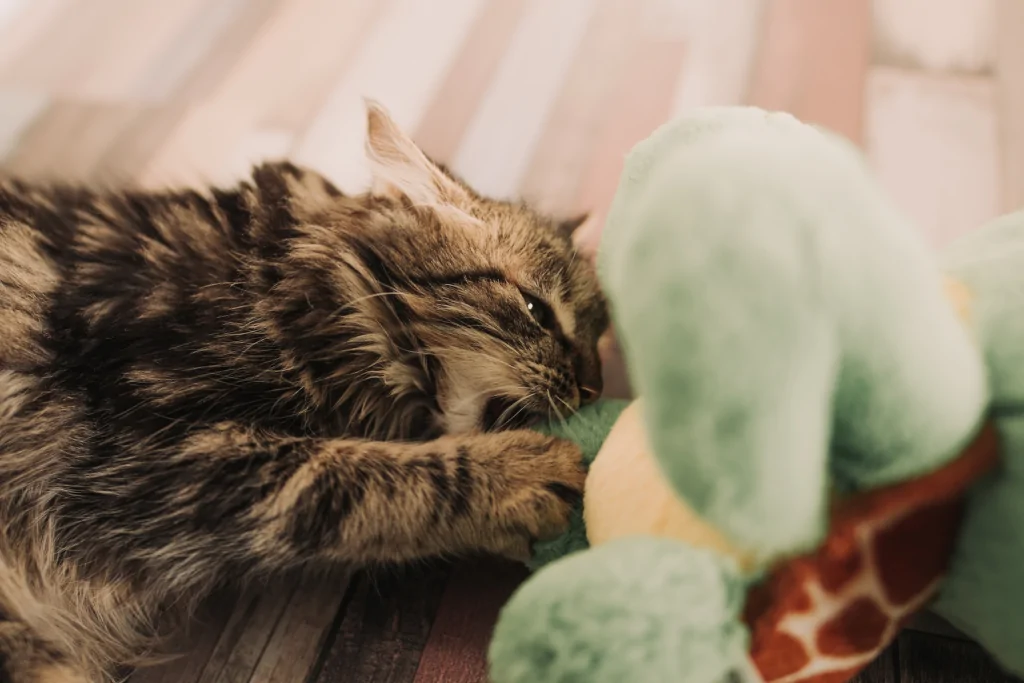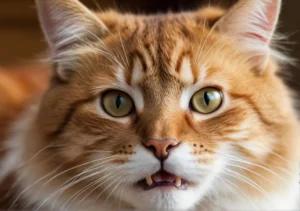Disclosure: We may earn a commission from helpful, relevant links in our content. No cost to you. See our privacy policy.
If you’ve ever been puzzled by your cat growling at a toy, you might wonder what’s causing this seemingly odd behavior. We’re here to help you decipher the mysterious world of feline playtime and why your cat may be growling at toys.
In this blog post, we’ll explore the different reasons why your cat might be growling at its toy and offer practical solutions to keep playtime enjoyable for both you and your feline friend.

Why Does My Cat Growl at Its Toy?
When a cat growls at a toy, it’s often due to their natural hunting instincts kicking in.
In the wild, cats are predators, and their playtime often mimics the hunting process. Growling at a toy is often their way of expressing excitement, capturing their “prey,” and protecting it from potential competitors.
Is It Normal for Cats to Growl During Playtime?
Yes, it’s normal for some cats to growl during playtime, especially when they are highly engaged in the activity. This behavior is a way for them to practice their predatory instincts and communicate their emotions.
However, if the growling is accompanied by other aggressive behaviors or signs of stress, it may indicate an underlying issue that needs to be addressed. Just like when puppies growl at toys, you need to be able to understand why it happens, and how to deal with it.
How to Deal With Toy Aggression in Cats
In this section, we’ll list some of the best ways to to manage and prevent toy aggression in cats. You can use these in various settings, depending on your situation.
Identify the triggers
The first step in dealing with toy aggression in cats is to identify what triggers the aggressive behavior.
Observe your cat during playtime and take note of any specific toys, actions, or situations that seem to cause growling or aggression.
Once you know these triggers, you can then modify playtime to avoid or manage these situations. For instance, you may want to remove triggering toys or slowly desensitize your cat to the toy by gradually introducing it in a controlled, positive environment.
Provide a variety of toys (and rotate regularly)
Offering a variety of toys for your cat can help reduce toy aggression. Some cats may become overly possessive of a single favorite toy, leading to growling or other aggressive behaviors.
You can browse some of the best cat toys on Amazon. By providing multiple options, your cat will be less likely to fixate on a single toy and won’t display an aggressive behavior.
Modify playtime
Adjust your playtime routine to minimize the risk of toy aggression. Keep play sessions short and engaging, and avoid rough play or teasing your cat with toys that could encourage aggressive behavior.
Instead, focus on encouraging positive interactions and rewarding your cat for appropriate play.
Create a safe space
Providing a safe, quiet space for your cat to retreat to can help reduce the risk of toy aggression. Ensure your cat has a designated area where they can feel secure and comfortable, away from other pets or distractions.
This can help them feel less threatened and reduce the need for aggressive behavior during playtime.
Seek professional help if needed
If your cat’s toy aggression persists or worsens despite your efforts, it may be time to consult with a veterinarian or a professional cat behaviorist. They can help identify any underlying issues, such as anxiety or medical conditions, that may be contributing to your cat’s aggression and recommend appropriate treatments.
My own cat’s toy aggression:
I realized that I needed to make some changes to our playtime routine. I decided to introduce a variety of toys and made a conscious effort to keep play sessions short and engaging. Over time, Smokey’s toy aggression decreased, and our playtime became a more enjoyable experience for both of us. You may want to try something similar. (Here are best cat toys on Amazon.)
The Role of Territorial Behavior in Toy Aggression
Territorial behavior can play a significant role in toy aggression, as cats may view toys as part of their territory or resources. When they perceive a threat to their possessions, they may growl or show other aggressive behaviors to protect their “property.”
To manage and prevent toy aggression related to territorial behavior, ensure each pet in your household has their own set of toys and play areas. This way, your cat can feel secure in its territory and is less likely to exhibit toy aggression, even if it’s two male cats in house.
You can also work on building trust between your cat and other pets or family members through positive reinforcement, joint activities, and slow introductions. Here’s how each one works:
- Positive reinforcement. Praise your cat and offer treats whenever they display appropriate behavior around other pets or family members. This helps them associate positive experiences with their interactions.
- Joint activities. Encourage playtime or feeding sessions involving both your cat and other pets or family members. This can help build positive associations and foster a stronger bond between them.
- Slow introductions. Gradually introduce your cat to new pets or family members, starting with short, supervised interactions and gradually increasing the duration as they become more comfortable with each other. This allows your cat to adjust to the new presence at their own pace.
FAQs
Should I take the toy away when my cat growls at it?
If your cat growls at a toy, it’s best to temporarily remove it to prevent escalation of aggression, and then reintroduce it later under controlled circumstances.
Are there certain toys that are more likely to cause growling?
Toys that trigger a cat’s hunting instincts, like those resembling prey, may be more likely to cause growling, but it varies depending on the individual cat.
Can growling at toys be a sign of stress or anxiety in my cat?
Growling at toys could be a sign of stress or anxiety in your cat, especially if it’s accompanied by other behavioral changes or if the aggression is uncharacteristic.
What other behaviors might indicate toy aggression in cats?
Other behaviors that might indicate toy aggression include hissing, swatting, biting, and overly rough play.
Alex, a passionate animal lover, has experience in training and understanding animal behavior. As a proud pet parent to two dogs and three cats, he founded AnimalReport.net to share insights from animal experts and expand his knowledge of the animal kingdom.




